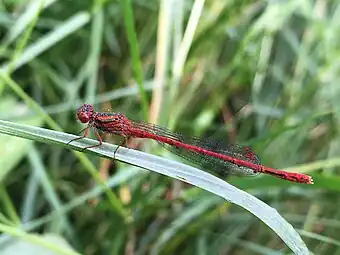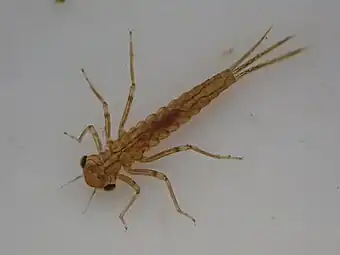| Xanthocnemis zealandica | |
|---|---|
 | |
| Male holotype specimen held at the Auckland War Memorial Museum. | |
 | |
| Female allotype specimen held at the Auckland War Memorial Museum. | |
| Scientific classification | |
| Domain: | Eukaryota |
| Kingdom: | Animalia |
| Phylum: | Arthropoda |
| Class: | Insecta |
| Order: | Odonata |
| Suborder: | Zygoptera |
| Family: | Coenagrionidae |
| Genus: | Xanthocnemis |
| Species: | X. zealandica |
| Binomial name | |
| Xanthocnemis zealandica (McLachlan, 1873) | |
| Synonyms | |
| |
Xanthocnemis zealandica, commonly known as common redcoat damselfly,[1] red damselfly, or red coat damselfly, is one of the most common native New Zealand damselflies.[2] Adult damselflies are often seen flying around vegetation close to streams.
Taxonomy
This species was first described by Robert McLachlan in 1873 and named Telebasis zealandica.[3] Until 1981, it was the only species in the endemic New Zealand genus Xanthocnemis.[4][5]
Description
The larvae of the red damselfly are identified by their pointed tail gills and long hairs by the tip.[6]
Distribution
This species is endemic to New Zealand and is widespread and common on North, South and Stewart Islands.[7][8]
Habitat
X. zealandica larvae are widespread across New Zealand, occurring in rocky and weedy streams and ponds.[6] It is predominantly a low-altitude species but can reach 1,945 m (6,381 ft) above sea level.[1]
Behaviour
X. zealandica has a 2–3 year life cycle; the shorter one was observed near sea level while the longer one was characteristic to a mid-elevation site (579 m (1,900 ft) above sea level). Some individuals at the lowland site may even complete their life cycle in one year.[9]
Adults are most active at high air temperatures and they are not active when the temperature of the air falls below 14°C.[10] Mature females deposit one egg at a time, just below water level, whereas mature males patrol these areas and sometimes form swarming groups.[10]
X. zealandica individuals can become infested by larval water mites in the genus Arrenurus.[11] Infected damselflies may have up to 62 mites, but there was no evidence that the mating behaviour of infested male damselflies was affected.[11]
Conservation status
X. zealanica has been classified by the Department of Conservation as "Not threatened".[12]
Gallery
 Red damselfly adult male observed in Christchurch, New Zealand
Red damselfly adult male observed in Christchurch, New Zealand Red damselfly nymph observed on the North Island, New Zealand
Red damselfly nymph observed on the North Island, New Zealand_sitting_on_a_log.jpg.webp) Red damselflies sitting on a log at Zealandia Ecosanctuary, Wellington, New Zealand
Red damselflies sitting on a log at Zealandia Ecosanctuary, Wellington, New Zealand
References
- 1 2 3 Rowe, R. (2020). "Xanthocnemis zealandica". IUCN Red List of Threatened Species. 2020: e.T197094A83372380. doi:10.2305/IUCN.UK.2020-1.RLTS.T197094A83372380.en. Retrieved 4 October 2021.
- ↑ "Fast versus slow: differing life history strategies of two New Zealand damselfly (Odonata: Zygoptera) species". www.wikidata.org. Retrieved 2024-01-14.
- ↑ McLachlan, Robert (1873). "A Catalogue of the Neuropterous Insects of New Zealand ; With Notes, and Descriptions of new Forms". The Annals and Magazine of Natural History; Zoology, Botany, and Geology. 12: 30–42 – via Biodiversity Heritage Library.
- ↑ Rowe, Richard J. (1981-01-01). "A New Species of Xanthocnemis Tillyard (Odonata: Coenagrionidae) from the Chatham Islands, New Zealand". Records of the Auckland Institute and Museum. 18: 205–209.
- ↑ Rowe, Richard J. (1985-01-01). A taxonomic revision of the genus Xanthocnemis (Odonata: Coenagrionidae) and an investigation of the larval behaviour of Xanthocnemis zealandica (Thesis). UC Research Repository.
- 1 2 "Red damselfly (Coenagrionidae: Xanthocnemis)". Landcare Research. Retrieved 2012-04-26.
- ↑ "Xanthocnemis zealandica (McLachlan, 1873)". biotanz.landcareresearch.co.nz. Retrieved 2023-12-20.
- ↑ "Fast versus slow: differing life history strategies of two New Zealand damselfly (Odonata: Zygoptera) species". www.wikidata.org. Retrieved 2024-01-14.
- ↑ Deacon, K.J. (1979). The Seasonality of four Odonata species from mid Canterbury, South Island, New Zealand (PDF) (Ph.D. thesis). Canterbury University.
- 1 2 Crumpton, W. J. (1975-01-01). "Adult behaviour of Xanthocnemis zealandica McLachlan and Austrolestes colensonis White at selected South Island (N. Zealand) habitats (Zygoptera: Coenagrionidae, Lestidae)". Odonatologica. 4 (3): 149–168.
- 1 2 Mckee, Dermot; Harvey, Ian; Thomas, Matt; Sherratt, Tom N. (2003-01-01). "Mite infestation of Xanthocnemis zealandica in a Christchurch pond". New Zealand Journal of Zoology. 30 (1): 17–20. doi:10.1080/03014223.2003.9518320.
- ↑ N. Grainger; J. Harding; T. Drinan; K. Collier; B. Smith; R. Death; T. Makan; J. Rolfe (November 2018). "Conservation status of New Zealand freshwater invertebrates, 2018". New Zealand Threat Classification Series. 28: 1–29. ISSN 2324-1713. OCLC 1083380599. Wikidata Q76413677.
External links
- Xanthocnemis zealandica discussed on RNZ Critter of the Week, 22 December 2023
